Modern kitchens have transformed from basic cooking spaces into multifunctional hubs where design, technology, and lifestyle come together. As homeowners seek smarter layouts, sustainable choices, and elevated aesthetics, new trends are reshaping how kitchens look and function. These changes are not driven by style alone. They reflect shifting habits, increased time spent at home, and a growing focus on wellness and convenience. Here are the emerging trends that are redefining modern kitchen design and setting the direction for the future.
1. Minimalist Layouts with Clean Visual Lines
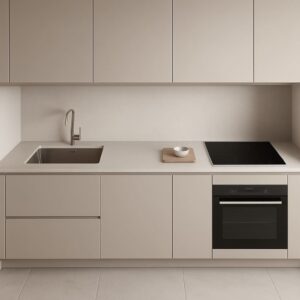 Minimalism continues to lead kitchen design, but it is moving beyond plain surfaces. Modern minimalist kitchens focus on visual calm, uninterrupted lines, and seamless finishes. Handleless cabinetry, concealed appliances, and integrated storage remove visual clutter and make the kitchen feel more open. Neutral tones like warm beige, off white, and soft grey bring a soothing atmosphere while keeping the space timeless.
Minimalism continues to lead kitchen design, but it is moving beyond plain surfaces. Modern minimalist kitchens focus on visual calm, uninterrupted lines, and seamless finishes. Handleless cabinetry, concealed appliances, and integrated storage remove visual clutter and make the kitchen feel more open. Neutral tones like warm beige, off white, and soft grey bring a soothing atmosphere while keeping the space timeless.
This trend appeals to homeowners who want a kitchen that feels peaceful and organized. The goal is not to remove personality. Instead, it creates a space where design elements stand out without overwhelming the room.
2. Smart Storage that Maximizes Every Inch
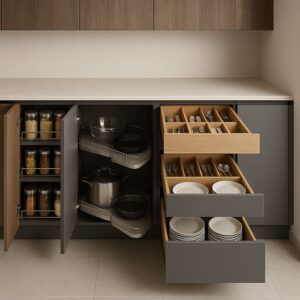 With compact urban homes on the rise, storage is becoming more intelligent and customized. Deep drawers with internal organizers, corner pull-outs, vertical pantry systems, and under-cabinet compartments help utilize areas that often go unused. Modern kitchens now include hidden charging stations, appliance garages, and modular inserts for cutlery and spices.
With compact urban homes on the rise, storage is becoming more intelligent and customized. Deep drawers with internal organizers, corner pull-outs, vertical pantry systems, and under-cabinet compartments help utilize areas that often go unused. Modern kitchens now include hidden charging stations, appliance garages, and modular inserts for cutlery and spices.
The trend focuses on reducing countertop clutter and improving workflow. A well-planned storage system makes cooking easier and ensures that everything has a dedicated place. Designers are treating storage as a core component rather than an afterthought.
3. Multifunctional Kitchen Islands
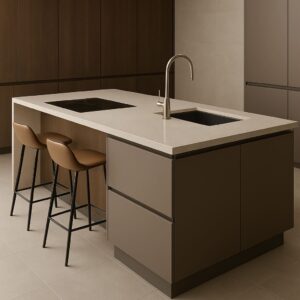 Kitchen islands have evolved far beyond simple counter extensions. They now serve as dining spaces, prep zones, storage units, and social hubs. Many modern islands include built-in sinks, under-counter refrigerators, induction cooktops, and seating for casual meals.
Kitchen islands have evolved far beyond simple counter extensions. They now serve as dining spaces, prep zones, storage units, and social hubs. Many modern islands include built-in sinks, under-counter refrigerators, induction cooktops, and seating for casual meals.
Homeowners prefer larger islands that allow cooking and interaction at the same time. This trend reflects how the kitchen has become the heart of the home. Instead of isolating the cook, the space encourages connection. The multifunctional island supports daily life, entertaining, and flexible use throughout the day
4. Seamless Integration of Smart Appliances
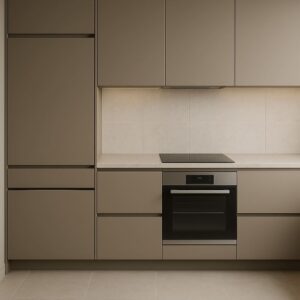 Technology is playing a major role in modern kitchen design. Smart refrigerators with internal cameras, induction cooktops with safety sensors, and voice-assisted appliances are becoming more accessible. Automation features such as app-controlled lighting, thermostats, and water-saving faucets contribute to efficiency and convenience.
Technology is playing a major role in modern kitchen design. Smart refrigerators with internal cameras, induction cooktops with safety sensors, and voice-assisted appliances are becoming more accessible. Automation features such as app-controlled lighting, thermostats, and water-saving faucets contribute to efficiency and convenience.
The goal is not to create a futuristic space. It is to make everyday tasks simpler and more intuitive. Homeowners appreciate appliances that learn habits, improve safety, and help manage time.
5. Natural Materials and Organic Textures
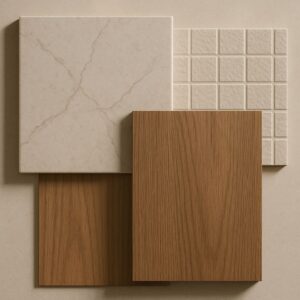 There is a strong shift toward earthy tones and organic finishes that bring warmth to modern kitchens. Stone-inspired countertops, matte surfaces, textured backsplashes, and wooden cabinetry create depth and a natural feel. This trend responds to the desire for calm, grounding environments inside the home.
There is a strong shift toward earthy tones and organic finishes that bring warmth to modern kitchens. Stone-inspired countertops, matte surfaces, textured backsplashes, and wooden cabinetry create depth and a natural feel. This trend responds to the desire for calm, grounding environments inside the home.
Materials like engineered stone, terrazzo, and natural wood pair well with minimalist layouts. They provide durability and visual character without appearing overly decorative.
Soft lighting enhances these textures and adds a comfortable atmosphere.
6. Sustainable and Low-Maintenance Surface Choices
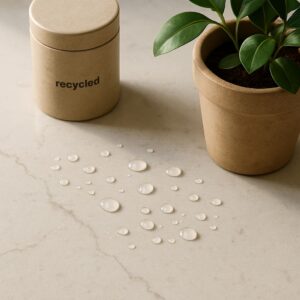 Sustainability is no longer a trend. It is a priority for modern homeowners. Kitchen surfaces are evolving toward eco-friendly and low-maintenance options that offer long-term value. Engineered quartz, terrazzo, and other advanced surfaces are gaining popularity because they resist stains, scratches, and heat while supporting healthy indoor air quality.
Sustainability is no longer a trend. It is a priority for modern homeowners. Kitchen surfaces are evolving toward eco-friendly and low-maintenance options that offer long-term value. Engineered quartz, terrazzo, and other advanced surfaces are gaining popularity because they resist stains, scratches, and heat while supporting healthy indoor air quality.
Eco-friendly certifications, recycled materials, and responsible manufacturing now shape buying choices. Homeowners want premium-looking, sustainable kitchens that last longer and require less upkeep.
7. Warm Color Palettes and Soft Contrast
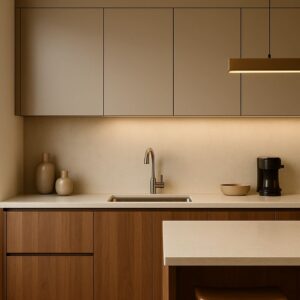 While white kitchens were once dominant, modern designs now embrace warmer shades. Cream, sand, taupe, and clay tones are replacing stark whites and cool greys.
While white kitchens were once dominant, modern designs now embrace warmer shades. Cream, sand, taupe, and clay tones are replacing stark whites and cool greys.
Soft contrast combinations, such as light stone countertops with walnut cabinetry, create inviting and upscale kitchens. Accent colors are used sparingly through bar stools, lighting fixtures, or open shelf decor. The overall effect is harmonious and welcoming rather than bold and busy. Warm palettes work well with natural textures and suit both small and large spaces.
8. Layered and Functional Lighting
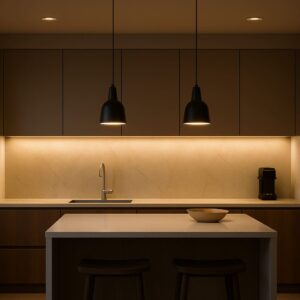 Lighting has become one of the most influential design elements in modern kitchens. Layered lighting strategies combine task lighting, ambient lighting, and subtle accent illumination. Under-cabinet strips, recessed ceiling lights, and elegant pendant fixtures enhance both beauty and usability. Modern homeowners prioritize well-lit work zones for safety and comfort.
Lighting has become one of the most influential design elements in modern kitchens. Layered lighting strategies combine task lighting, ambient lighting, and subtle accent illumination. Under-cabinet strips, recessed ceiling lights, and elegant pendant fixtures enhance both beauty and usability. Modern homeowners prioritize well-lit work zones for safety and comfort.
Lighting is also used to highlight textures, create mood, and visually expand the space. The trend moves away from single central fixtures toward thoughtfully planned illumination throughout the kitchen.
9. Open Layouts with Living Space Connection
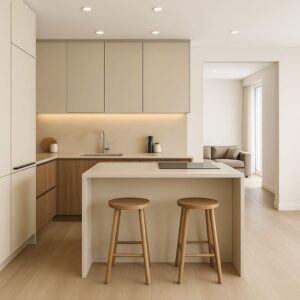 Open kitchen layouts continue to grow in popularity because they support social living and visual flow. The kitchen is no longer a separate service area. It connects with dining and living rooms to create a unified space.
Open kitchen layouts continue to grow in popularity because they support social living and visual flow. The kitchen is no longer a separate service area. It connects with dining and living rooms to create a unified space.
Designers are focusing on acoustics, ventilation, and spatial zoning to maintain functionality. Partial glass partitions, breakfast counters, and dual-purpose furniture help separate activities without blocking openness. This trend reflects how families interact and how homes are used throughout the day.
10. Custom Personalization and Lifestyle Driven Design
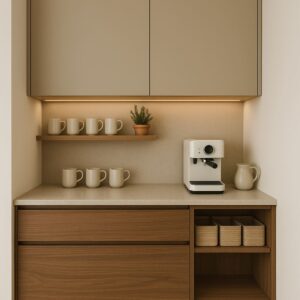 The future of kitchen design is personalization. Homeowners want spaces tailored to their routines. Coffee corners, baking stations, wine cooling units, herb growing shelves, and pet feeding zones are becoming common additions.
The future of kitchen design is personalization. Homeowners want spaces tailored to their routines. Coffee corners, baking stations, wine cooling units, herb growing shelves, and pet feeding zones are becoming common additions.
Rather than following a single look, kitchens now reflect individual lifestyles. Customization ensures that the space is not only aesthetically pleasing but also improves daily living. The trend makes the kitchen more meaningful and efficient for the people who use it.
A New Era of Kitchen Design
Modern kitchen design is moving toward smarter planning, natural comfort, and long-lasting materials. These emerging trends focus on improving function, wellness, and visual harmony. As homeowners continue to value thoughtful design and practical innovation, the kitchen will remain the most dynamic space in the home.
